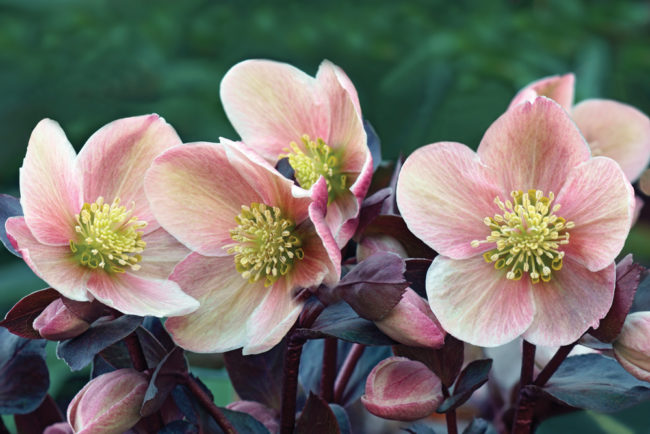
BY MOYA ANDREWS
The hardy Helleborus plants, both those that bloom at Christmas (Helleborus niger) and those that bloom during Lent (Helleborus orientalis) are wonderfully well-behaved citizens in our Indiana gardens. They are not native, but they are benign botanical residents that gardeners cherish for their longevity as well as their welcome winter blooms. Their origins are shrouded in antiquity, but it has been suggested that hellebores may have been brought to Britain by the Romans because of their medicinal value.
In medieval times, sick cattle were treated by monks who bored a hole through the animal’s ear to insert a piece of hellebore root, and hellebores were used to treat human maladies throughout the 16th and 17th centuries. All hellebores have large, distinctive, coarse, dark green, leathery, lobed, semi-evergreen leaves. The species that was used medicinally by the ancient Greeks was probably the Lenten rose (H.orientalis)—which is not a rose at all. They bloom for at least six weeks in February and March and have prolific bell-shaped flowers that can be pale green, white, cream, pink, dusty mauve, and maroon. These easy-care, cold-resistant perennials belong to the buttercup family, and most are hardy in USDA plant hardiness zones 4 through 9. There are about 15 species in the genus.

Plant hellebores in light to full shade in rich, evenly moist, well-drained soil that is neutral to alkaline. Established clumps are about 1 to 1 1/2 feet wide, and they get established the first year after planting and bloom the second. They require little care except to prune off, in the spring, all of the leaves that show winter damage.
One can also cut back the stems that have already bloomed to promote more blossoms, though this is easily accomplished by picking the stems of flowers to take into the house. Float the stemless blooms in a shallow bowl of water rather than putting the stems in a vase where they often droop.
Should you wish to divide the plants, do so after they have finished blooming, and handle them carefully. However, the easiest way to propagate hellebores is to dig the self-sown seedlings, near the mother plant, in spring or summer and replant them in new locations. These adaptable plants provide useful ground cover when they are not in bloom and tolerate freezing and thawing in the spring, our cold winters, and our dry summers without flinching.
However, I feel their most endearing characteristic for local gardeners may be the way the deer distain them. I have never seen a deer touch one of the many hellebores that grow in my garden where deer abound. Visit our local nurseries to buy one or two or 10 for your gardening Valentine—or buy some for yourself. There is no such thing as having too many hellebores in a garden.












